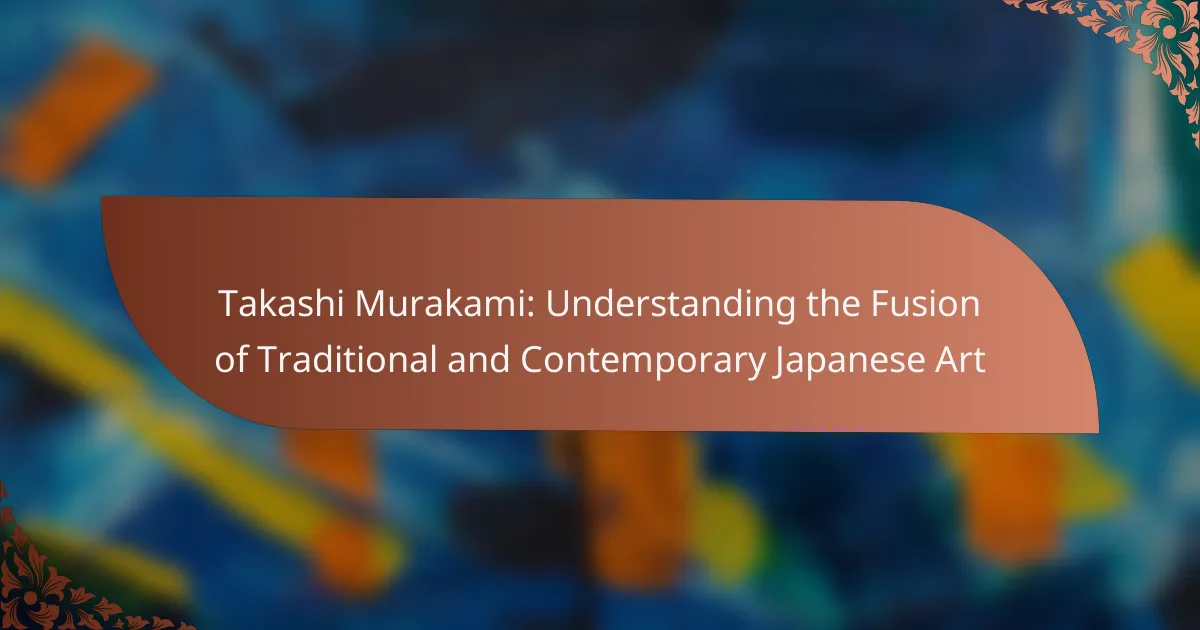Takashi Murakami merges traditional Japanese art with contemporary styles, creating accessible and vibrant artworks. This article will explore his Superflat style, critique of consumerism, and global collaborations. It will also examine his unique techniques and the lessons artists can draw from his fusion of heritage and modernity.
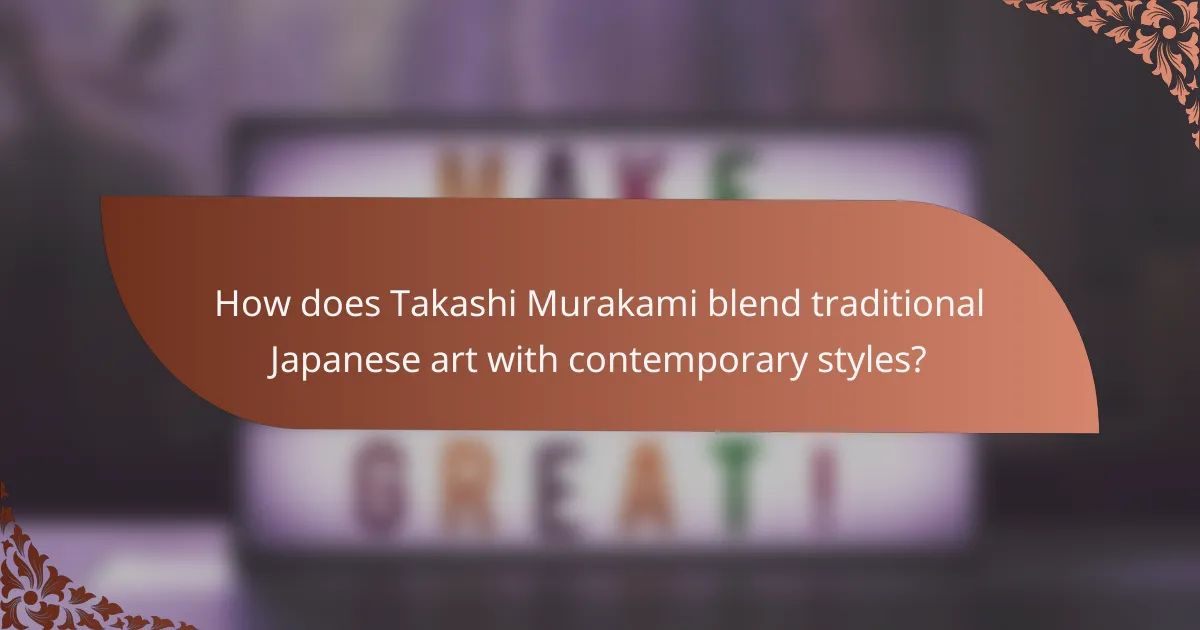
How does Takashi Murakami blend traditional Japanese art with contemporary styles?
Takashi Murakami skillfully blends traditional Japanese art with contemporary styles by integrating techniques like Nihonga with modern pop culture elements. His signature Superflat style reflects a unique fusion of historical motifs and contemporary visual language, creating vibrant, accessible artworks. This approach revitalizes traditional themes, making them relevant to today’s audience while maintaining their cultural essence. Murakami’s work exemplifies how art can transcend time, merging the past with the present in innovative ways.
What influences shape Murakami’s artistic vision?
Takashi Murakami’s artistic vision is shaped by a blend of traditional Japanese art, contemporary culture, and personal experiences. His work often reflects the influence of post-war Japanese society and the rise of consumerism. Murakami integrates elements of anime and manga, merging them with classical techniques like nihonga. This fusion creates a unique aesthetic that challenges conventional boundaries of art. Additionally, his collaborations with brands and artists expand his reach, further defining his modern artistic identity.
Which traditional techniques does Murakami incorporate into his work?
Takashi Murakami incorporates traditional techniques such as Nihonga painting, Ukiyo-e printmaking, and Sumi-e ink wash in his work. These methods blend with contemporary themes, creating a unique fusion of styles. Nihonga emphasizes natural pigments and traditional materials, while Ukiyo-e focuses on woodblock printing techniques. Sumi-e contributes expressive brushwork, enhancing the emotional depth of his art. This combination showcases Murakami’s commitment to preserving Japanese artistic heritage while innovating within the modern art landscape.
How does pop culture impact Murakami’s artistic expression?
Pop culture significantly influences Murakami’s artistic expression by integrating contemporary themes with traditional Japanese aesthetics. His work often reflects modern societal issues, consumer culture, and global trends, creating a dialogue between past and present. For instance, Murakami’s use of vibrant colors and cartoon-like characters resonates with contemporary visual culture, attracting a diverse audience. This fusion results in a unique artistic style that challenges conventional boundaries while celebrating Japan’s rich artistic heritage.
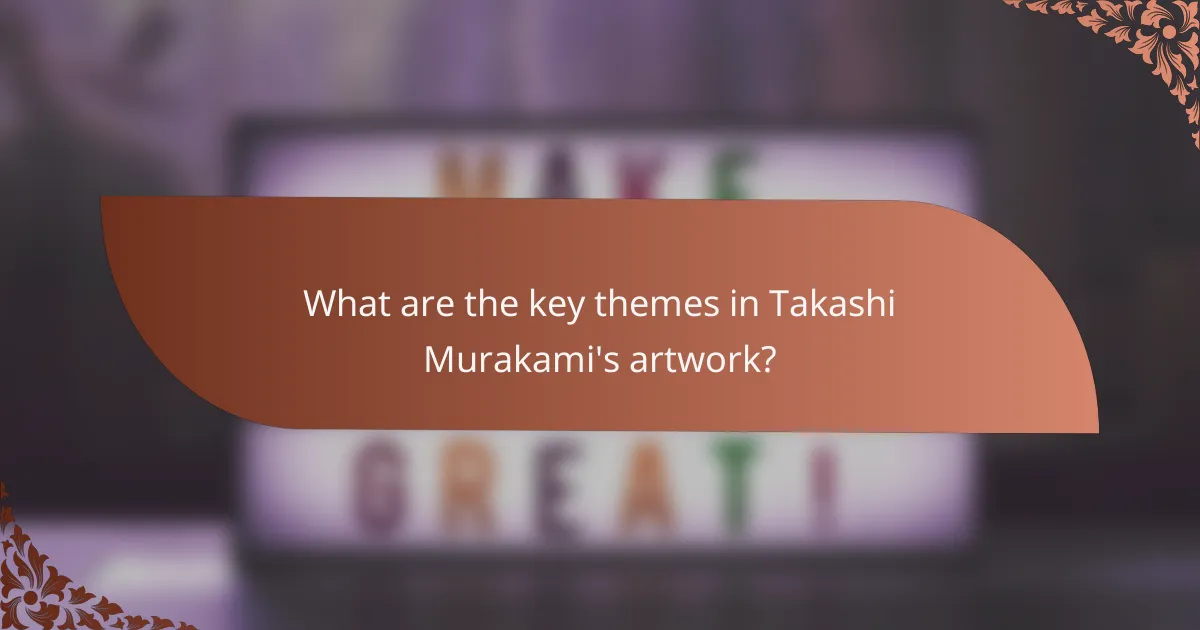
What are the key themes in Takashi Murakami’s artwork?
Takashi Murakami’s artwork explores themes of consumerism, the blending of high and low culture, and the interplay between traditional Japanese aesthetics and contemporary influences. His signature “superflat” style critiques societal values while celebrating Japanese pop culture. The use of vibrant colors and cartoonish characters reflects a unique attribute of merging fine art with commercial appeal. Additionally, Murakami often incorporates elements of nostalgia, addressing both historical and modern narratives in his pieces.
How does Murakami address consumerism in his art?
Takashi Murakami critiques consumerism through his art by blending traditional Japanese aesthetics with contemporary commercial culture. His works often feature pop culture icons and vibrant colors, reflecting society’s obsession with consumer goods. Murakami’s Superflat theory illustrates how consumerism flattens cultural hierarchies, merging high and low art. This unique perspective challenges viewers to reconsider their relationship with mass production and materialism.
What role do flowers and smiling faces play in his pieces?
Flowers and smiling faces symbolize joy and positivity in Takashi Murakami’s art. They reflect a fusion of traditional Japanese aesthetics with contemporary themes. The vibrant colors and playful imagery create an inviting atmosphere, engaging viewers emotionally. This unique attribute enhances the overall experience of his work, making it accessible and relatable.
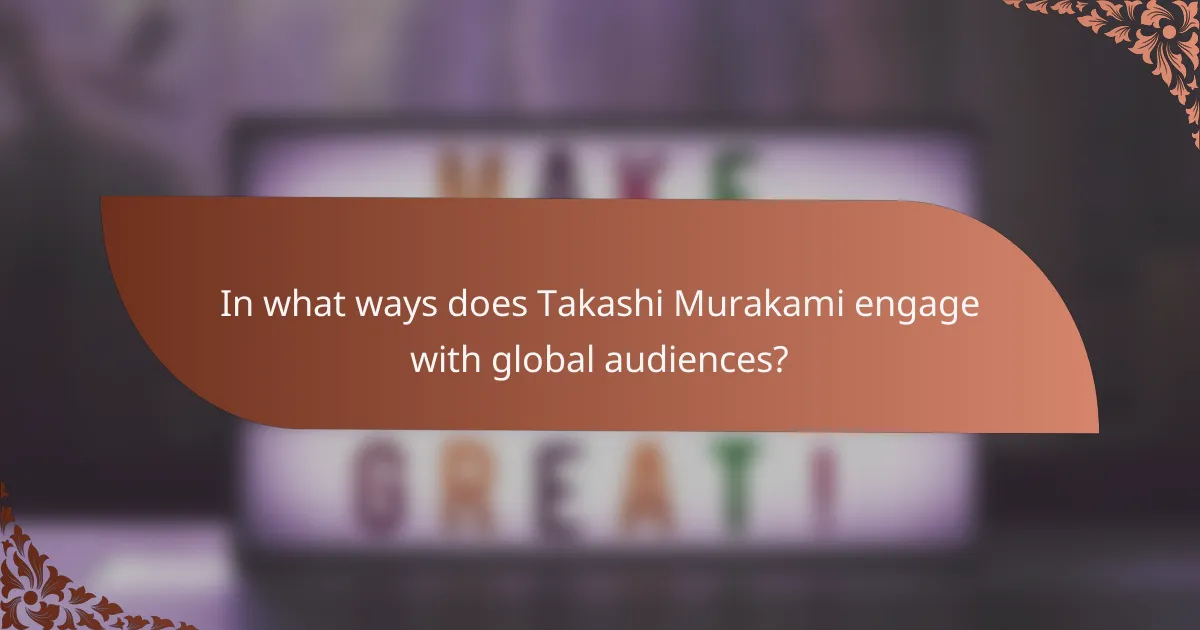
In what ways does Takashi Murakami engage with global audiences?
Takashi Murakami engages global audiences through vibrant art that blends traditional and contemporary Japanese styles. His use of recognizable motifs, such as flowers and smiling characters, resonates universally. Collaborations with global brands like Louis Vuitton expand his reach, merging high art with popular culture. Additionally, his exhibitions often incorporate interactive elements, enhancing audience participation and connection.
Which exhibitions have significantly impacted Murakami’s international presence?
Takashi Murakami’s international presence has been significantly impacted by exhibitions like “Superflat” and “The 500 Arhats.” “Superflat,” launched in 2000, showcased his unique blend of traditional and contemporary styles, gaining widespread attention. “The 500 Arhats,” presented in 2013, further solidified his status, featuring intricate works that reinterpret Buddhist themes. These exhibitions highlighted Murakami’s ability to merge cultural heritage with modern aesthetics, enhancing his global recognition.
How do regional perceptions of Murakami’s work differ across cultures?
Regional perceptions of Murakami’s work vary significantly, influenced by cultural contexts. In Japan, his art often reflects traditional aesthetics, resonating deeply with local audiences. In contrast, Western viewers may interpret his fusion of pop culture and fine art as a commentary on consumerism. Asian countries may appreciate the blend of modernity and heritage, while Western critiques often focus on surrealism and existential themes. These differences highlight how cultural background shapes the interpretation of Murakami’s unique artistic attributes.
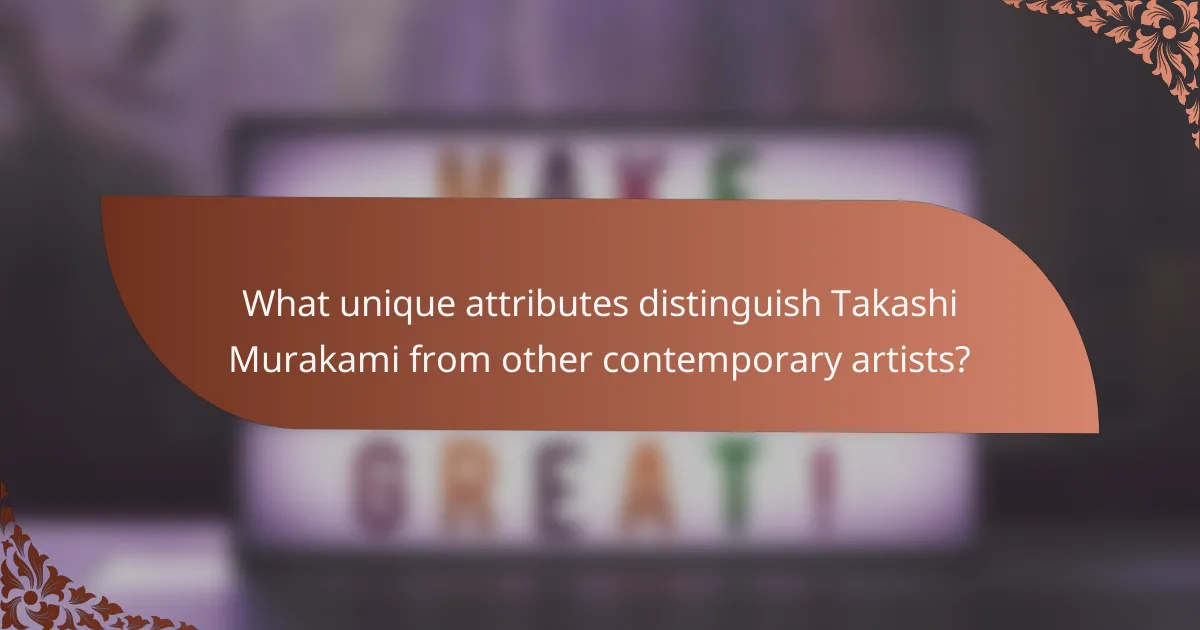
What unique attributes distinguish Takashi Murakami from other contemporary artists?
Takashi Murakami stands out due to his unique blend of traditional Japanese aesthetics and contemporary pop culture. His signature style, characterized by vibrant colors and playful motifs, reinterprets classic themes. Murakami’s distinctive approach, known as “superflat,” flattens visual hierarchies, merging high art with commercial influences. Additionally, his engagement with global art markets and collaborations with brands like Louis Vuitton set him apart from peers. This fusion of art and commerce highlights a rare attribute in contemporary art, making his work both accessible and culturally significant.
How does Murakami’s collaboration with brands redefine art and commerce?
Takashi Murakami’s collaboration with brands redefines art and commerce by merging high art with consumer culture. This fusion creates accessible art forms, enhancing brand visibility while elevating Murakami’s artistic reach. His unique approach allows for the exploration of contemporary themes within traditional Japanese aesthetics, resulting in innovative products that resonate with diverse audiences. By blurring the lines between art and commercialism, Murakami challenges perceptions and invites broader participation in the art world.
What makes Murakami’s Superflat movement a significant contribution to art history?
Takashi Murakami’s Superflat movement significantly contributes to art history by blending traditional Japanese aesthetics with contemporary pop culture. This fusion challenges conventional boundaries, creating a unique visual language that resonates globally. Murakami’s work incorporates elements like flatness and bright colors, reflecting both historical influences and modern consumerism. As a result, Superflat has redefined the understanding of art in the global context, emphasizing the interplay between high and low culture.
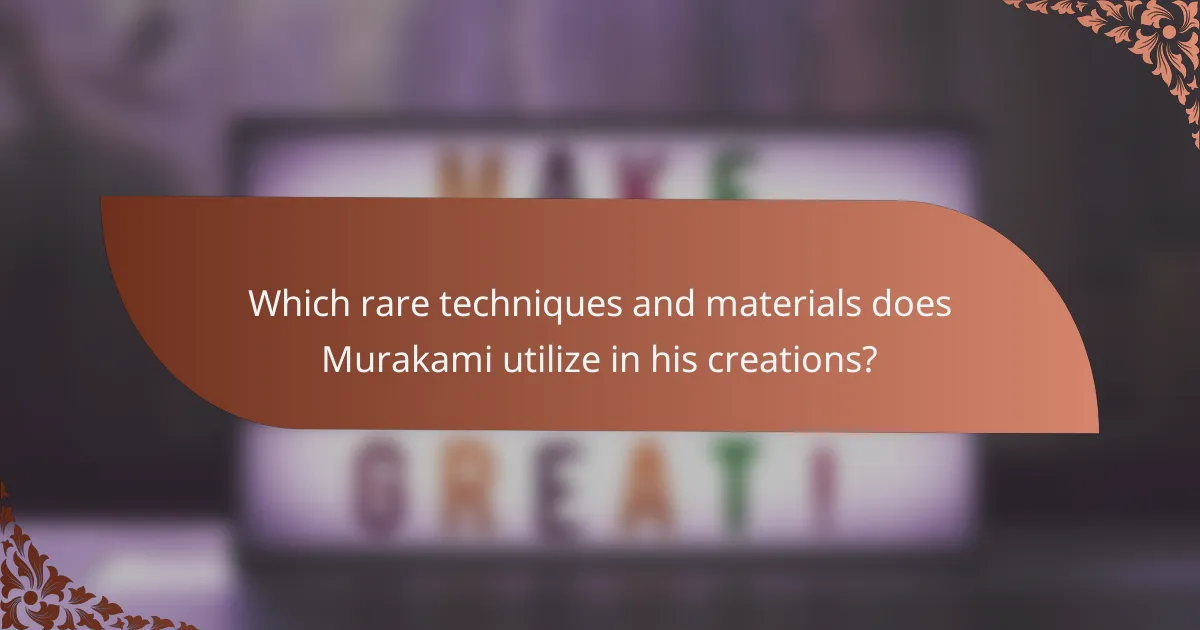
Which rare techniques and materials does Murakami utilize in his creations?
Takashi Murakami employs rare techniques and materials like gold leaf, traditional silk, and unique resin casting in his artwork. These elements enhance the fusion of traditional and contemporary aesthetics. His use of advanced digital printing methods also sets his creations apart, allowing for intricate designs and vibrant colors. Additionally, Murakami incorporates cultural motifs, blending them with modern pop art influences to create distinctive visual narratives.
What innovative methods does Murakami employ in his large-scale installations?
Takashi Murakami employs innovative methods like blending traditional Japanese techniques with contemporary themes in his large-scale installations. He uses materials such as acrylic paint and fiberglass to create vibrant, immersive environments. His signature style often incorporates motifs from Japanese pop culture, merging high art with commercial aesthetics. This fusion challenges conventional boundaries, inviting viewers to engage with art in novel ways. Additionally, Murakami’s installations frequently involve collaborative efforts with artisans, enhancing the authenticity of traditional craftsmanship while embracing modern artistic expressions.
How does Murakami’s use of digital technology enhance his artwork?
Murakami’s use of digital technology enhances his artwork by enabling innovative techniques and broader accessibility. Digital tools allow for precise manipulation of colors and forms, creating a unique fusion of traditional and contemporary styles. This integration reflects his unique attribute of blending pop culture with fine art, resulting in vibrant, engaging pieces. Additionally, digital platforms expand the reach of his work, making it accessible to a global audience and inviting interaction.
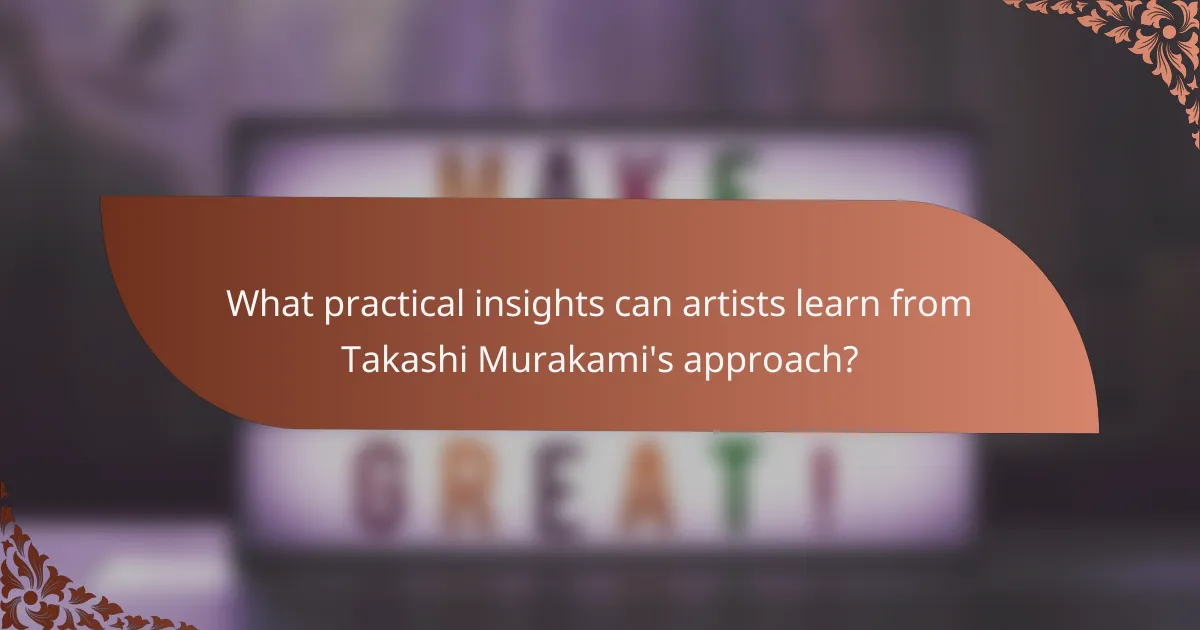
What practical insights can artists learn from Takashi Murakami’s approach?
Artists can learn to blend traditional techniques with contemporary themes from Takashi Murakami’s approach. His work exemplifies the fusion of historical Japanese art with modern pop culture, creating a unique aesthetic. This integration allows artists to reach broader audiences while preserving cultural heritage. Additionally, Murakami’s use of vibrant colors and playful motifs encourages experimentation and innovation in artistic expression. By embracing both tradition and modernity, artists can develop distinctive styles that resonate with contemporary viewers.
Which best practices can emerging artists adopt from Murakami’s career?
Emerging artists can adopt several best practices from Takashi Murakami’s career. Embrace the fusion of traditional and contemporary art to create a unique style. Collaborate with brands and other artists to expand reach and visibility. Leverage social media for direct engagement with audiences, showcasing work and process. Focus on building a strong personal brand that resonates with cultural themes. Lastly, maintain a balance between commercial success and artistic integrity to sustain long-term relevance.
What common mistakes should artists avoid when exploring fusion art?
Artists exploring fusion art should avoid superficial blending of styles, neglecting cultural context, and failing to innovate. These mistakes can dilute the essence of both traditional and contemporary elements. Understanding Takashi Murakami’s approach highlights the importance of depth and authenticity in fusion art. He successfully merges traditional Japanese aesthetics with modern themes, creating a unique narrative that resonates with diverse audiences. Artists should prioritize meaningful integration over mere aesthetic combination to achieve genuine fusion.
